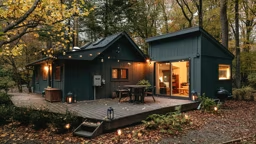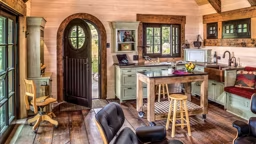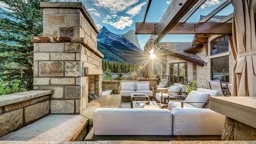Nature lovers out there: Remember when it was a good thing to “take only pictures and leave only footprints?” In this age of green-speak, many cabin enthusiasts are aiming to tread lightly and lessen their impact on the land, water and the natural surroundings that make cabin living so special.
But some of the green terminology can be confusing. For instance, there are “ecological footprints,” “carbon footprints,” “small footprints” and more.
An ecological footprint relates to our overall resource use, while a carbon footprint (or track) represents the quantity of greenhouse gasses our lifestyle produces.
One way to score better on both counts is to consider what size dwelling you need and what kind of space and resources it requires. The days of Think Big are being replaced by simpler living in structures with small footprints.
We asked Ross Chapin, an award-winning architect recognized for his ecological designs, about small footprints.
But some of the green terminology can be confusing. For instance, there are “ecological footprints,” “carbon footprints,” “small footprints” and more.
An ecological footprint relates to our overall resource use, while a carbon footprint (or track) represents the quantity of greenhouse gasses our lifestyle produces.
One way to score better on both counts is to consider what size dwelling you need and what kind of space and resources it requires. The days of Think Big are being replaced by simpler living in structures with small footprints.
We asked Ross Chapin, an award-winning architect recognized for his ecological designs, about small footprints.
CL: So what’s all the talk about a “small footprint?” What does that mean?
RC: When I started out designing, I never tried to design small, but that’s what I’ve been doing for 30 years. I design for the most livability.
“Small” is a relative term. I try not to think of it so much as small as fully lived in. “Small” for a couple, and “small” for a family of six with extended family coming up to the lake are different. It sounds a little awkward, but I prefer “sensibly-sized.”
A smaller cottage can feel alive and lived in because every square foot is lived in. There is less unused space. (And when I say “used space,” I mean space that is used during every trip to your cottage or cabin.)
If you’ve got rooms that might be saved for parents coming once a year or formal dining on special occasions, while nice, they’re not needed. More to heat, more to clean, more to build – chuck it. Well, maybe I should say, “I suggest letting it go.”
RC: When I started out designing, I never tried to design small, but that’s what I’ve been doing for 30 years. I design for the most livability.
“Small” is a relative term. I try not to think of it so much as small as fully lived in. “Small” for a couple, and “small” for a family of six with extended family coming up to the lake are different. It sounds a little awkward, but I prefer “sensibly-sized.”
A smaller cottage can feel alive and lived in because every square foot is lived in. There is less unused space. (And when I say “used space,” I mean space that is used during every trip to your cottage or cabin.)
If you’ve got rooms that might be saved for parents coming once a year or formal dining on special occasions, while nice, they’re not needed. More to heat, more to clean, more to build – chuck it. Well, maybe I should say, “I suggest letting it go.”
CL: So are you saying people should build smaller and forego the extras?
RC: The idea is not about lacking space, or less than enough space, or poverty of space; it’s more about celebrating all that you have, living in what you have fully. It’s about living simply and living well.
How big a space do you actually live in? I have a neighbor who has about 5,000 square feet. When I asked him how much he actually uses on a day-to-day basis, it’s about 1,400 square feet. If you’re going to create a new house, base it on how you live.
CL: Any thoughts specifically about cabins and cottages?
RC: With a weekend cabin, you can get by with less for a long weekend or limited time. You’re there for the experience in many flavors and colors. You may not need all you have in a large house, such as a library or media room. You need a place that welcomes family and welcomes friends.
Sometimes, overflow sleeping in a little curtained alcove is absolutely the best, as opposed to a separate full guest suite with a separate bathroom and a big closet. Oftentimes, people would rather sleep on the living room sofa where the life is – that is cabin living.
I have friends who have a beach cabin with a boathouse. Their place is not very large, and above the boathouse there’s a tiny little loft. To sleep in this loft looking over the water – that’s a dream. The air, the light, the sounds … it beats any fancy bedroom.
CL: As a cabin owner, why should I care about my use of space?
RC: Do you enjoy coming up to the cabin and spending your time on cleaning and projects? It’s a lifestyle, it’s your life savings and in the big picture: a greener way of living. Some of the reasons [for choosing a small footprint] are selfish and some are altruistic.
CL: Did you have a cabin growing up?
RC: Growing up, my father built a pontoon boat, which was really a wooden raft on drums. We had a picnic table in the middle, and we’d take it out into the lake and roll out the sleeping bags. It was our affordable cabin … and very memorable.
Lucie Amundsen’s favorite small footprints are the ones her children leave in the sand during walks on the beach.
Reader Resource: For more info about architect Ross Chapin, including his “GoodFit” cottage plans under 1,300 square feet, visit www.rosschapin.com.
RC: The idea is not about lacking space, or less than enough space, or poverty of space; it’s more about celebrating all that you have, living in what you have fully. It’s about living simply and living well.
How big a space do you actually live in? I have a neighbor who has about 5,000 square feet. When I asked him how much he actually uses on a day-to-day basis, it’s about 1,400 square feet. If you’re going to create a new house, base it on how you live.
CL: Any thoughts specifically about cabins and cottages?
RC: With a weekend cabin, you can get by with less for a long weekend or limited time. You’re there for the experience in many flavors and colors. You may not need all you have in a large house, such as a library or media room. You need a place that welcomes family and welcomes friends.
Sometimes, overflow sleeping in a little curtained alcove is absolutely the best, as opposed to a separate full guest suite with a separate bathroom and a big closet. Oftentimes, people would rather sleep on the living room sofa where the life is – that is cabin living.
I have friends who have a beach cabin with a boathouse. Their place is not very large, and above the boathouse there’s a tiny little loft. To sleep in this loft looking over the water – that’s a dream. The air, the light, the sounds … it beats any fancy bedroom.
CL: As a cabin owner, why should I care about my use of space?
RC: Do you enjoy coming up to the cabin and spending your time on cleaning and projects? It’s a lifestyle, it’s your life savings and in the big picture: a greener way of living. Some of the reasons [for choosing a small footprint] are selfish and some are altruistic.
CL: Did you have a cabin growing up?
RC: Growing up, my father built a pontoon boat, which was really a wooden raft on drums. We had a picnic table in the middle, and we’d take it out into the lake and roll out the sleeping bags. It was our affordable cabin … and very memorable.
Lucie Amundsen’s favorite small footprints are the ones her children leave in the sand during walks on the beach.
Reader Resource: For more info about architect Ross Chapin, including his “GoodFit” cottage plans under 1,300 square feet, visit www.rosschapin.com.
 Kate Loudon
Kate Loudon 











